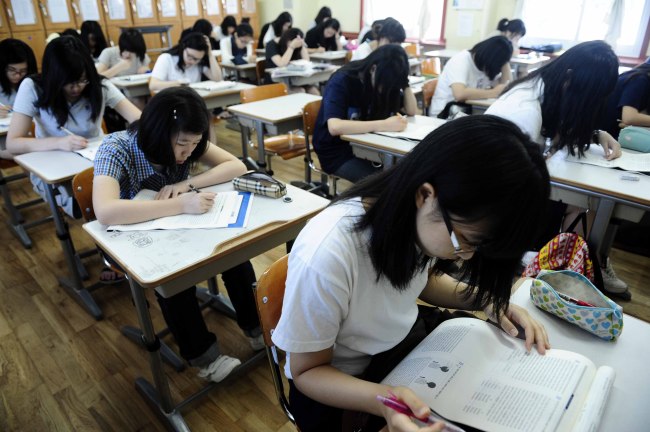Education is slipping down the list of spending priorities for low-income households in South Korea, while high-earning households are spending the largest share of their income to educate thier children, a study showed on Wednesday.
According to the study by the Korea Institute for Health and Social Affairs, Korean households that belonged to the wealthiest 20 percent of the population spent an average of 616,965 won ($523) a month to educate their children last year.
Households that belonged to the poorest 20 percent, on the other hand, spent 236,025 won a month.
According to the study by the Korea Institute for Health and Social Affairs, Korean households that belonged to the wealthiest 20 percent of the population spent an average of 616,965 won ($523) a month to educate their children last year.
Households that belonged to the poorest 20 percent, on the other hand, spent 236,025 won a month.

Throughout 1998 to 2014, food was the biggest expense for low-earning households in Korea, followed by housing, children’s education and dining or traveling.
While they always spent the biggest portion of their income on food during this period, the group has been spending more on housing and less on education since 2010. The lowest-income group of households spent 13.3 percent of their income to educate their children in 2010, but only 11.7 percent last year.
The proportion of their income spent on housing, on the other hand, increased from 15.8 percent to 17.1 percent in the same period. Throughout the years, their lowest expenditure went to traveling and dining out.
Households in the wealthiest 20 percent, on the other hand, always spent the largest share of their income on their children’s education from 1998 to 2014, followed by dining or traveling, food and housing. The order did not change throughout the years. Last year, they spent the least on housing -- 8.8 percent of their total income -- while spending the largest amount, 15.1 percent, on their children’s education.
Education has been regarded as the key to social mobility in Korea, where 80 percent of high school students are estimated to have enrolled in college since 2000. The country is also notorious for its competitive education system. The average Korean high school student studies up to 13 hours a day and sleeps only 5.5 hours a night.
Also, the country has the highest reliance on the private education market among the Organization for Economic Cooperation and Development nations. While 37.2 percent of the funding for educational institutes came from the private sector in Korea last year, 97 percent of education costs in Sweden and Denmark were paid by government.
Researcher Park Jong-seo, who wrote the study, said Korean families, especially the low-earning ones, are burdened by the education cost for their children.
“I think this is one of the reasons why the fertility rate is low in the country,” he said. “Most Koreans think it’s the parent’s responsibility to make sure his or her child gets the best education possible, which leads to better life and employment opportunities. Now, people feel burdened by this responsibility and choose not to have children at all.”
While most Korean children have access to public education regardless of their socioeconomic status, not every child has access to pricy private education that often leads to better grades and other opportunities, he said. This eventually leads to an increasing economic inequality and decreasing social mobility, he said.
“We need two things,” Park said. “One is to reform the current education system, which relies too much on the private education sector. The other is to increase welfare benefits to low-earning households so they have better access to more cultural and social resources for their children.”
By Claire Lee(dyc@heraldcorp.com)







![[Graphic News] More Koreans say they plan long-distance trips this year](http://res.heraldm.com/phpwas/restmb_idxmake.php?idx=644&simg=/content/image/2024/04/17/20240417050828_0.gif&u=)
![[KH Explains] Hyundai's full hybrid edge to pay off amid slow transition to pure EVs](http://res.heraldm.com/phpwas/restmb_idxmake.php?idx=644&simg=/content/image/2024/04/18/20240418050645_0.jpg&u=20240419100350)





![[From the Scene] Monks, Buddhists hail return of remains of Buddhas](http://res.heraldm.com/phpwas/restmb_idxmake.php?idx=652&simg=/content/image/2024/04/19/20240419050617_0.jpg&u=20240419175937)

![[KH Explains] Hyundai's full hybrid edge to pay off amid slow transition to pure EVs](http://res.heraldm.com/phpwas/restmb_idxmake.php?idx=652&simg=/content/image/2024/04/18/20240418050645_0.jpg&u=20240419100350)

![[Today’s K-pop] Illit drops debut single remix](http://res.heraldm.com/phpwas/restmb_idxmake.php?idx=642&simg=/content/image/2024/04/19/20240419050612_0.jpg&u=)